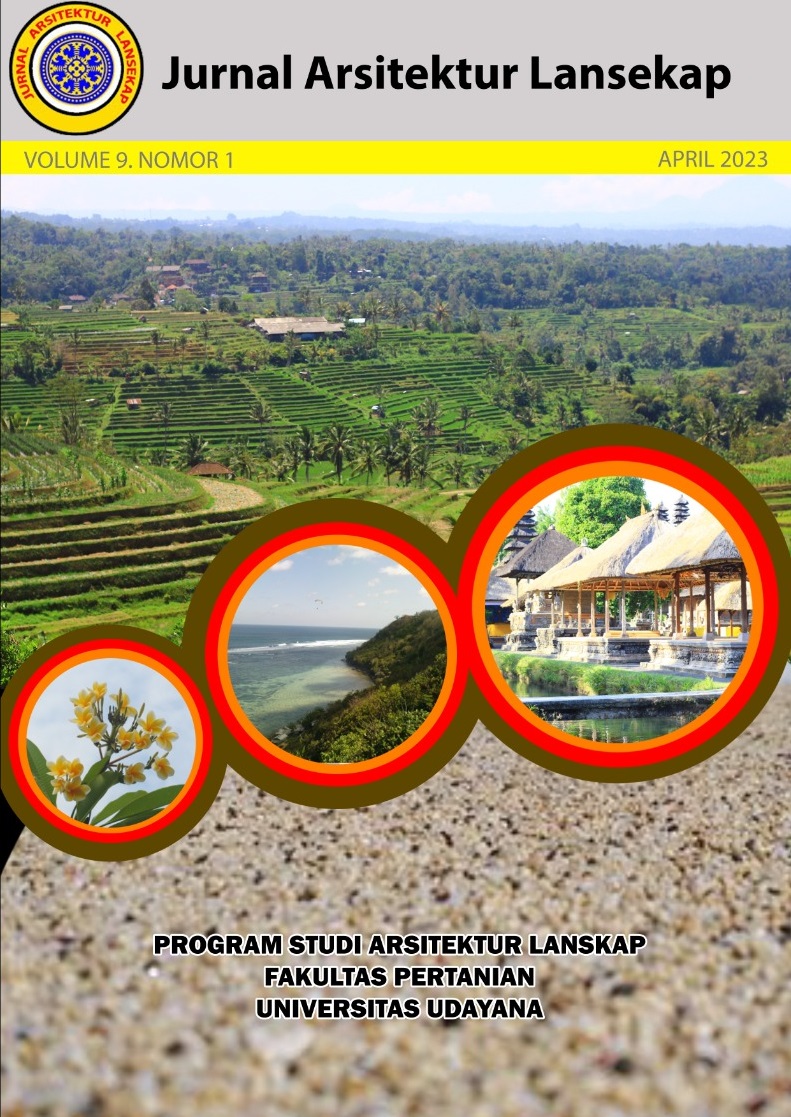Desain Lanskap Taman Dipangga sebagai Taman Sejarah dan Rekreasi berbasis COVID-19
Abstract
Landscape Design of Taman Dipangga as a Historical and Recreational Park based on COVID-19. Taman Dipangga is a city park with a strategic location and easy access. In the middle of the COVID-19 pandemic crisis, city parks, which are part of open public spaces, should be resilient and adaptive to the current situation. Taman Dipangga, likewise, must adapt to the current situation in terms of design and amenities. As one of the cultural and historical attractions in Bandar Lampung, Taman Dipangga has the potential to become one of the favorite tourist destinations for visitors. This research aims to design Taman Dipangga by highlighting the historical aspects as well as the recreational components that are responsive to COVID-19. This qualitative research was conducted using the survey method, which included observation, interview, and literature review that refers to the design process. This research leads to the use of historical and recreational concepts in Taman Dipangga to optimize the potential of Taman Dipangga by representing it through the Krakatau Monument, the form of design, the division of space and its naming, as well as the selection of vegetation based on the condition of the location on Mount Krakatau and the surrounding area. Taman Dipangga will be more than just a recreation park; it will also be a place for education and a cultural heritage site.
Downloads
References
Lampung, D. K. (2021). Statistik Sektoral Kota Bandar Lampung. Lampung, Indonesia.
Menteri Negara Lingkungan Hidup. (n.d.). tentang Baku Tingkat Kebisingan. KEPUTUSAN MENTERI NEGARA LINGKUNGAN HIDUP.
Menteri Pekerjaan Umum dan Penataan Ruang. (2008). Pedoman Penyediaan dan Pemanfaatan Ruang Terbuka Hijau di Kawasan Perkotaan. Peraturan Menteri Pekerjaan Umum.
Nicholas J. Stevens, S. G. (2021). The adaptive capacity of public space under COVID‐19: Exploring urban design interventions through a sociotechnical systems approach. Hum. Factors Man.
Slater, S. J., Christiana, R. W., & Gustat, J. (2020). Recommendations for Keeping Parks and Green Space Accessible for Mental and Physical Health During COVID-19 and Other Pandemics. PREVENTING CHRONIC DISEASE.
Taman Dipangga. (n.d.). Retrieved from direktoripariwisata.id: https://direktoripariwisata.id/unit/6550
Teruo Higashi, N. M. (1987). Forest Vegetation and the Nutritional Status of Soils on the Krakatau Islands, Indonesia. Soil Science and Plant Nutrition, 109.
UN-Habitat. (2020, June). UN-Habitat Guidance on COVID-19 and Public Space.

This work is licensed under a Creative Commons Attribution-ShareAlike 4.0 International License.
An author who publishes in the Jurnal Arsitektur Lansekap (JAL) agrees to the following terms:
- Author retains the copyright and grants the journal the right of first publication of the work simultaneously licensed under the Creative Commons Attribution-ShareAlike 4.0 License that allows others to share the work with an acknowledgement of the work's authorship and initial publication in this journal
- Author is able to enter into separate, additional contractual arrangements for the non-exclusive distribution of the journal's published version of the work (e.g., post it to an institutional repository or publish it in a book) with the acknowledgement of its initial publication in this journal.
- Author is permitted and encouraged to post his/her work online (e.g., in institutional repositories or on their website) prior to and during the submission process, as it can lead to productive exchanges, as well as earlier and greater citation of the published work (See The Effect of Open Access).
Read more about the Creative Commons Attribution-ShareAlike 4.0 Licence here: https://creativecommons.org/licenses/by-sa/4.0/.







